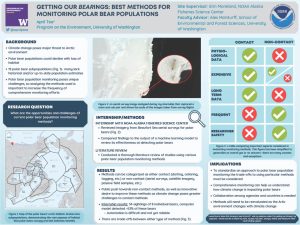Getting our Bearings: Best Methods for Monitoring Polar Bear Populations
As climate change grows in threat to the Arctic habitat of polar bears, having comprehensive and frequent population estimates is crucial. The purpose of this study was to evaluate the opportunities and challenges of different polar bear population monitoring methods to identify best practices and where advancements can be made. I interned with NOAA Alaska Fisheries Science Center and reviewed images from aerial population surveys for the presence of polar bears with the goal of reviewing the performance of a machine-learning algorithm to help automate imagery review and expedite the overall population estimate process. I also conducted a literature review where I evaluated polar bear population monitoring methods. In my research, I found that although there is a desire to move more towards non-invasive methods, the technology to easily do so is not yet developed enough to allow us to reliably get the same magnitude of data as that from invasive methods, which also provides important physiological data that helps us track bear health. Advancements in technology are promising for the future of non-invasive methods, but currently, invasive methods can be used to increase monitoring efforts and closely track this at-risk species. There has been more conversation recently about the ethics of invasive field research and desire to move towards non-contact methods, and there is particular concern and attention on polar bears. My results show that invasive methods are relatively safe for the bears and get the most thorough data so that we can better protect the polar bears.
